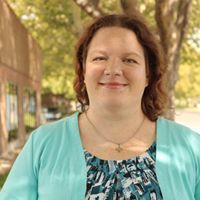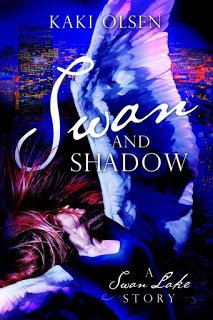Interview with Kaki Olsen author of Swan and Shadow

This Friday I'd like to welcome author Kaki Olsen. Tell us a little about yourself.
I’m a Boston-raised, BYU-educated Red Sox fan who writes in between her full-time job, her volunteer work and as much travel as she can fit in. I’ve been writing since elementary school, but it took me 16 years of non-fiction publications to get around to my debut novel. I write horror, mystery, sci-fi, fantasy, adventure and literary fiction as well as personal non-fiction. I have no kids, but I have six nephews, three nieces, one step-nephew, two fish and a lot of fictional characters to keep me company.
Wow you sound busy. Will you share a short excerpt from your novel?
I think it’s inevitable that every high school student read Kafka’s The Metamorphosis. Gregor Samsa, a traveling salesman, wakes up one day as a giant cockroach. He tries to live a normal life, even when everything’s changed. He can’t work or go out. He can’t find joy in things that used to make him happy. He overhears conversations about what a burden he is to the rest of his family. Eventually, he allows himself to die to put an end to that.
In all of Aislin’s years of homeschooling, I only asked to change the curriculum once. When Mom mentally replaced Gregor with Aislin, she removed it from the planned reading list without further argument.
It may be just a story, but I’ve seen some of the guilt Aislin feels for the circumstances she didn’t ask for. If anyone in this world knows what it was to wake up one day with a different life, it would be her.
Aislin has always said that I try to compensate for her lack of a life with my own activities. She scoffs at my attempts to keep her life normal, but I would rather risk her scorn than let her believe that she has nothing to contribute to our lives.
As far as I know, Aislin has never read that novella, but I’m sure that she knows the story too well.
What brought about the idea for this book?
I have always loved Swan Lake, but thought one night that the premise would be impossible in a modern context. Within ten minutes, I had imagined a life where a character was expected to find true love when she has human contact only with people she runs into at the all-night convenience stores.
Sounds interesting, I bet that would come with all sorts of challenges along with a bunch of interesting characters. Have you been given any helpful advice? If so What?
A few years ago, I took the author of Ella Enchanted out for lunch. We got around to talking about writing and she said that the best character tip she had been given was to search the pockets of the character in question. It’s how she came up with a book of proverbs that one of her kings uses as his guiding principles. It’s also how I found a rag doll that once belonged to the dead daughter of a prisoner of war.
I'll have to remember that one. That sounds like fun. Currently, what are you working on?
Last year, I published the story of an android who saves a human colony ship by illegally smuggling a dragon egg on board. My roommate encouraged me to write a collection of stories set in that world. The dragon now has an Italian adopted sister, goes to elementary and is passionate about voting rights for family pets.
I’m writing my first murder mystery and historical fiction, set in 1926 England, where the daughters of a stationmaster find a dead body on one of the trains to pass through their father’s station. It connects to a greater mystery and pattern of deaths.
My third project is entitled Here There Be Humans and chronicles the epic quest of young dragons to find their long-lost kin. The catch is that in the wider world, there are bloodthirsty monsters who kill dragons on sight and practically worship anyone who slays a dragon. When they finally meet a human, she is an autistic princess who is intimidated by humans as well and whose advisors want her to feel too incompetent to sit on the throne.
It looks like you are keeping busy. I find jumping back and forth between stories keeps me from getting bored. Tell us a little bit about your main characters
Swan and Shadow is the story of twin sisters. Aislin is homeschooled, intelligent, reserved and uninterested in taking risks. Maeve plays three sports, dates regularly and has made it her mission in life to find her younger sister a boyfriend. This is complicated by the fact that Aislin is so wary of taking risks because she is the latest in a string of Byrnes who have spent their days as swans and their nights as humans. She has a deadline for breaking the curse and is terrified that she will screw it all up, but it takes another catastrophe to take her own destiny in hand. Maeve feels guilty about the life that her sister can’t live just because the curse only afflicts one member of the family. She sees everything she does as well-intentioned and an acceptable level of interference.
What was your favorite scene to write?
Aislin and her love interest go to see The Nutcracker and discuss how crappy most ballet stories are to the main characters. Only one of them knows that she’s living the crappy story of Swan Lake. I loved writing the dramatic irony of that and it takes place as they’re sitting on the subways that I rode in high school.
What has been the best compliment you have received since you released Swan and Shadow?
My book came out in March. I gave my best friend a copy of Brandon Sanderson’s Calamity for her birthday in late Febraury and she said I could borrow it after she finished reading. When I tried to borrow it, though, she said she’d put the book down until she finished reading my book. I got very angry that she had her priorities wrong, but when she announced at the end that my book was phenomenal, I forgave her. (She’s also the person who proofread draft 3, which caught my publisher’s attention.)
That ties with a commentary from my first male reader. His wife bought the book for his birthday and since he was the 83-year-old, gruff, no-nonsense tenor who sat behind me in choir rehearsal, I wasn’t sure he’d like a fairy tale retelling. One day, he approached me and said, “Kathryn, you’re writing the rest of that story, right?” “Yes, I will.” “Good,’ he muttered. “Otherwise, I’d have to kill you.”
What kind of research do you do before you start a new story?
It depends on the story. For Swan and Shadow, I researched folk tales and swan behavior. I watched videos of flight patterns. I calculated range because someone asked me if the swan ever got out of reach of home. She is the same person who found me a Roman recipe for roast swan.
For What Is Behind Him,my murder mystery, I’ve been researching such things as shell-shock, inter-war home life, socioeconomic problems, the history of the British railways, the development of the BBC programming, fashion in the 1920s, burial customs in rural England, educational opportunities for women, war service of certain battalions and wildflowers of Southeast England.
I think my most interesting research was for Here There Be Humans. I decided that the dragons needed to run into a human who catches them off-guard and immediately, a 17-year-old girl walked into my mind. She was dainty and well-dressed, but also very nervous in appearance and prone to fluttering her hands like tiny wings. She wouldn’t tell me why this was because I knew immediately that she had a verbal output disorder and I spent several weeks finding out what her symptoms meant. Eventually, I ran across Fragile X Syndrome, which manifests at time as high- functioning autism in females, and I knew I had her diagnosis. I’ve since read books from the perspective of people on the Autism Spectrum Disorder and talked to parents of autistic children. I even found a name meaning “swallow,” which fit her birdlike mannerisms. In a book on Tudor life, I discovered that the mentally impaired were listed as innocents because they could not be held accountable for their actions. So Princess Celandine the Innocent was born, a name which suggests she’s virtuous, but is actually a sly insult to her disorder.
Who designed the artwork for your cover? Or did you design it yourself?
Cedar Fort sends a questionnaire about cover ideas out with their book contracts. I then got an e-mail with a proof of the cover. I gave feedback and was surprised to have a good friend of mine respond. Rebecca Greenwood works as one of their artists and is a published author in her own right, but I knew her from church and she even was in a musical that I helped choreograph one summer.
Kaki, how do you handle criticism when it comes to your writing?
Most of the time, I remember that it’s not personal. If I have a specific issue that I refuse to change, I discuss it with the critic. For example, my acquisitions editor wanted me to change the ending to Swan and Shadow. I told her in detail why it had to end that way, but she still disagreed. Eventually, I wrote something in the middle and she loved it.
In another case, my proofreader objected to an insecurity of a main character and went on at inappropriate length about how annoying it was. By the end of the manuscript, I was ready to scream. We worked out that it was a matter of the character never developing from beginning to the end in regards to that insecurity.
I think the hardest part is knowing when to take it and when to leave it. How many times do you think you read your book before going to print?
14. I kept track.
https://www.amazon.com/dp/B01BO8K8I0/ref=dp-kindle-redirect?_encoding=UTF8&btkr=1
www.kakiolsenbooks.com
novel-ties.blogspot.com
@kakiolsenbooks
https://www.facebook.com/kakiolsenbooks

Published on January 26, 2018 03:42
No comments have been added yet.



